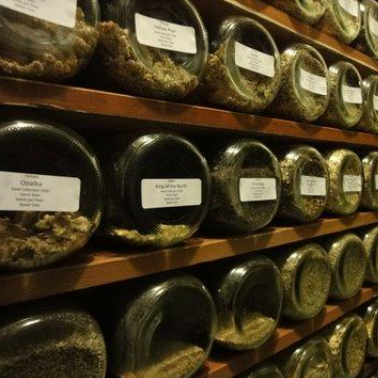
Oh Say Can You Seed? Seedy Vocabulary for Home Gardening

Gardeners have their own lingo. Some like to use tongue twisting Latin names, others can rattle off useful products like winnow baskets and squid hoes that are little known outside food growers and seed savers. But some of the most important terms are those used by sowing circles, the words that appear in catalogs and on seed packs that tell you about your seeds and how to sow them. Here’s a few that we use frequently and think could stand for a little definition.
Heirloom: This term was coined in the 1970s and popularized in the 90s as a way of showing that some open-pollinated seeds are cherished and passed down from generation to generation the way a family carpet or painting might be. An heirloom seed or variety (not just tomatoes!) is one that has been grown within a family or community or region for a period of many generations. They "grow true," meaning that gardeners can continue to save seed from the variety and grow plants with consistent characteristics year after year. The debate over heirlooms is how old is old enough to qualify as an heirloom. We consider a variety that has been grown for 50-100 years an heirloom. Some of these are family heirlooms--such as Hank's X-tra Special Baking Bean and Upstate Oxheart Tomato--which were donated to us by individuals. Others are commercial heirlooms, seeds that have been commercially available for at least 50 years, though we don’t know the seed’s story before it was offered in a seed catalog. Some, like Jenny Lind Melons, are regional heirlooms, grown by many gardeners throughout a region for many years.
Either way, heirlooms were developed over generations for characteristics that are important to gardeners and eaters such as flavor, beauty, cultural recipes, and regional adaptations. That's why we love them!
Hybrid: We don’t sell any hybrid seeds. That’s because we want you to be able to save seeds from year to year, and you can’t do that with a hybrid. A hybrid variety is the offspring of a cross between two genetically different parent plants of the same species resulting in a first generation plant (F1) with some characteristics of both parents. Hybrids are usually developed for mono-crop and industrial farming purposes like shipability, mechanical harvesting, high yield (requiring high chemical inputs) and shelf life. Not all seed catalogs tell you which varieties are hybrids. One clue is if it says F1, you know it's a hybrid. You don't have to worry about accidentally buying hybrids with us! We do, however, have some contemporary heirlooms whose best qualities have been untangled from their hybrid fore-bearers. Bridge to Paris peppers are one example; selected over successive seasons out of hybrid La Paris, this variety's deliciousness has only improved.
GE: Genetically engineered seeds have acquired modified genes from other organisms by laboratory "gene transfer" methods. We don’t sell any genetically engineered seeds. In fact, we won’t even buy seeds (even heirlooms) from any company owned or related to bio-tech corporations. Sometimes referred to as GMO or Genetically Modified Organisms, GE seeds are primarily developed for industrial chemical agriculture purposes such as resistance to chemical herbicides and to deliver pharmaceuticals to animals.
Ready to sow your heirloom seeds? Here are three terms you should know.
 Doug tending hoophouse tomato seedlings in soil block trays.
Doug tending hoophouse tomato seedlings in soil block trays.1. Start under protection. In the northeast, when we say "start under protection" (or "start early") we are referring to starting seeds in small pots or soil blocks either indoors, in a greenhouse, or in a cold frame. Tomatoes, onions, peppers, eggplants and some herbs, all need to be started early and transplanted outside after last frost. Many other crops happily adapt to this treatment, too--and produce earlier yields because of it. Check out our Seed-Starting 101 series to learn more.
2. Direct sow. The bulk of the varieties in our catalog can be direct sown. This means you can plant them directly in the ground after last frost. Direct sown seeds are no-fuss, easy seeds to grow. If you don’t want to start seeds early indoors, stick to seeds that can be direct sown.
3. Succession sow. Some plants are fast growers and will bolt (flower and go to seed) quickly. Cilantro is a good example of this. To make sure we have cilantro for a longer season, we plant in succession. Try planting new seeds every week or two when we recommend succession sowing.
Here are some other helpful definitions:
Cotyledon: an embryonic leaf that looks much different from the eventual plant leaves, the cotyledons are the first leaves of any seedling. For most vegetables--except for corn--there are two symmetrical cotyledons. The first "true leaves" appear after the cotyledon and are specialized for photosynthesis.
Cross-Pollination: Transfer of pollen from anther to stigma on two different plants.
Cultivar: A named cultivated variety of plant.
Genetic Diversity: The complete range of genetic differences expressed by plants of the same variety.
Genetic Erosion: The gradual, persistent loss of genetic resources.
Open-pollinated: Non-hybrid plant reproduced from two parents of the same variety that displays the same characteristics as the parent plants.
Selection: The process by which specific characteristics of a plant are retained over time.
Standard Variety: A non-hybrid plant selected generation after generation until completely stabilized.
True-to-type: A plant that, when grown year after year, maintains the same characteristics expected of the variety.
Variety: Closely related plants with near exact characteristics.






